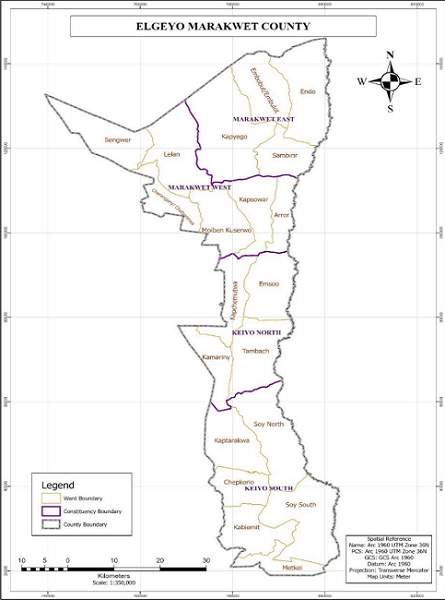Elgeyo Marakwet County General Profile
Elgeyo Marakwet County is in the North Rift region of Kenya. The County borders West Pokot to the North, Baringo to the East, South-East and South, Uasin-Gishu to the South West and West, and Trans-Nzoia to the North West. The County occupies an estimated area of 3029.8 square kilometers and has a population of 454,480 according to the 2019 National Census. It is inhabited predominantly by Keiyo and Marakwet ethnic groups of the Kalenjin community. There are variations in population distributions and densities within the county with the average density being 150 persons per Km2 . The County has 4 sub counties namely Keiyo North, Keiyo South, Marakwet West and Marakwet East. Keiyo south is the largest with 899.7 Km2 of all the four sub-counties and Keiyo North sub-county has the smallest area of 541.0 Km2. Keiyo North has the highest population density of 168 persons per Km2 while Marakwet East has the lowest with 129 persons per Km2 (Census, 2019). The high density in Keiyo North could be attributed to it being largely on the Highland’s geographic area thus having favourable climatic conditions and fairly developed infrastructure. The population distribution in the County varies according to a geographical area with the highland areas of Keiyo South and Marakwet West sub-counties having higher populations than the lowlands and the middle-altitude zones. The county is further subdivided into 20 Wards with 74 Locations and 212 Sub-locations.
According to the 2019 census, the population of Elgeyo Marakwet county was 454,480 with a population density of 150 people per square KM and a growth rate of 2.8%. The county has a current projected population of 503,019 people. with an average household size of 5 members. The ratio of males to females is 1:1 with females being slightly higher compared to males at 227,317and 227,151 respectively. Population under 15 years is the highest followed by adults (25-59 years) and the least being adolescents of 20-24 years. 42% of the population that is aged less than 15 years and 5% of the aged population being above 60 years and a productive population of 52% that is aged 15-59 years. The increase in population 2 growth and distribution applies pressure on the health system thus calling for the identification of strategies to expand the capacity of healthcare services, especially the ante-natal and postnatal services
Elgeyo Marakwet county health delivery system is organized into 4 tiers of care as per the norms and standards. These tiers include community, dispensaries, Health Centres, Sub County Hospitals and Referral Hospital. The community services focus on demand creation for the services, while the other levels focus on responding to the demand. The county hosts Iten County Referral Hospital that is a level Five Hospital which is a referral facility serving the entire County and the neighboring Counties. Level four (4) public hospitals include Tambach, Chebiemit, Kapcherop, Chebororwa, Kapsowar Mission, Tot, Kocholwo, Kaptaraka and Kamwosor. There are 33 health centers and 94 dispensaries. The average distance to a health facility is 3.7 Km as compared to the national average which stands at 5 Km as a result of construction of several new facilities. The county experiences shortage of staff as doctor to patient ratio currently stands at 1:8,000 and nurse to patient ratio stands at 1:1000.

The County literacy levels stands at 84.6% (Male 81.9% Female 87.3%) of population aged 15 years and above with ability to read and write (2014), high fertility rates of 4.1 (2015-2020), (slightly higher than the national average of 3.8%). short birth intervals between pregnancies, low contraceptive prevalence rate of 56.9 (MCPR 2022), high teenage pregnancies of 3/10 pregnant women (KHIS 2020), entrenched cultural and religious barriers, mobile populations (pastoralists), hard to reach arears and poor road terrain. The rough terrain and traditions that perceive delivery at health facilities as implying they are unable to deliver normally, combined with the FGM and it its effects frequently leads to obstructed labour and subsequent fistula and in some instances, death . Maternal mortality rate is at 187/100.000 livebirths and an infant mortality rate of 9.7/1000 . Haemorrhage, eclampsia, sepsis, unsafe abortion, and obstructed labour are all direct causes of maternal death. Anaemia and malaria are the most common indirect causes. The county has a total of 139 health facilities with a density of 2.6 per 10,000 population, against the World Health Organization’s (WHO) recommendation of 2.03b. It has a core health workforce density of 9.9 core personnel per 10,000 citizens, against WHO’s recommended 23 health worker.
The county is patriarchal society, women generally have limited rights regarding their reproductive health, education, and land ownership. FGM is still at 27.9 in female aged 15-49 years. Maternal health service coverage is poor: <30% of the population has access to services; 98.1% attend ANC but only 65% of pregnant women have skilled assistance at delivery with 75% of the mothers do not go for postnatal care (KDHS).

